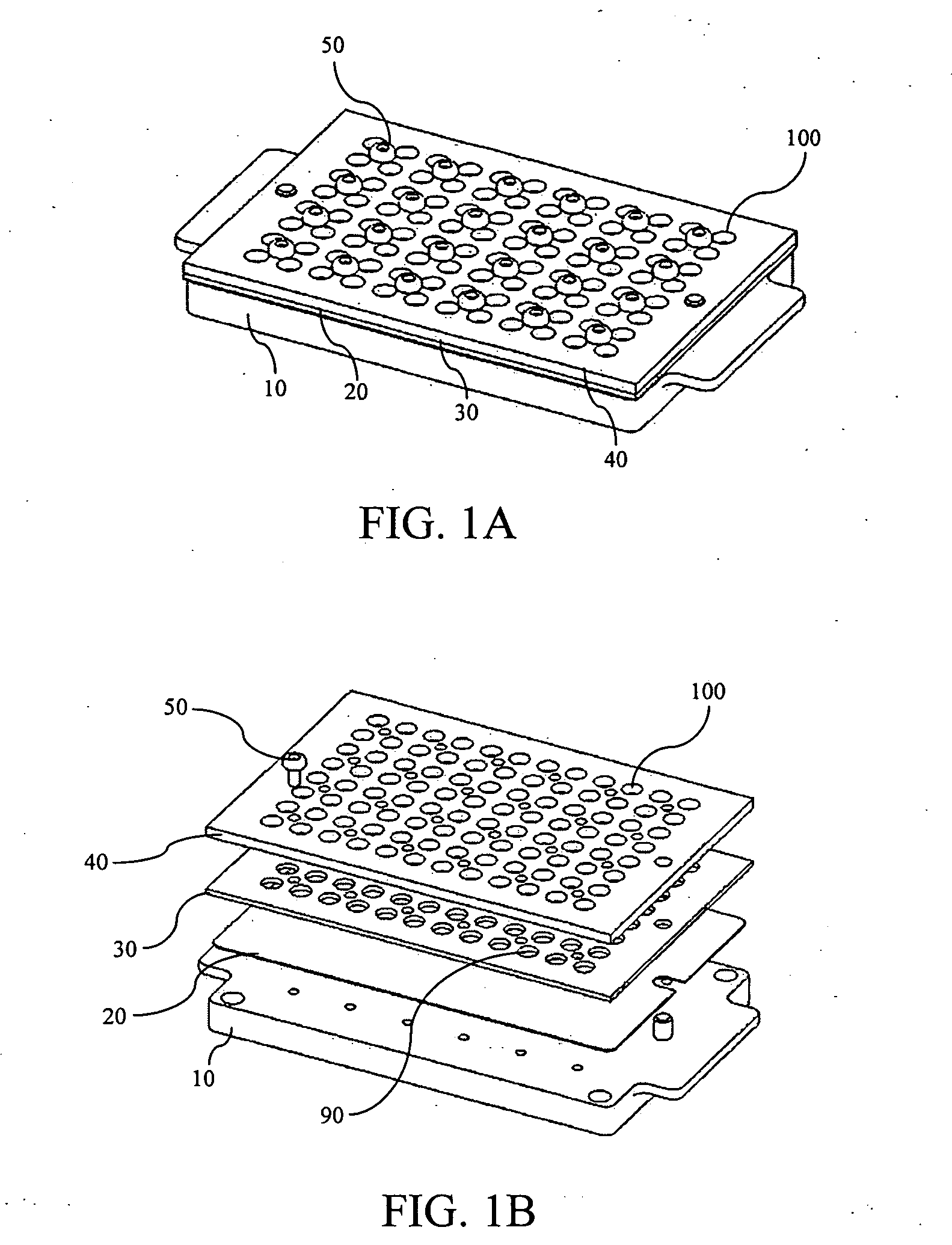Combinatorial hydrogel formulation
a technology of hydrogel and hydrogel gel, which is applied in the direction of sequential/parallele process reactions, instruments, library creation, etc., can solve the problems of poor mechanical performance, insufficient cell mass for larger constructs, and inability to provide hydrogels in biomedical device applications
- Summary
- Abstract
- Description
- Claims
- Application Information
AI Technical Summary
Benefits of technology
Problems solved by technology
Method used
Image
Examples
example 1
Polymerization of Sample Array in the Presence of Epidermal Tissue In-Situ Using Ultraviolet (UV) Light
[0094] This example demonstrates that a single hydrogel solution can be formulated, stratum corneum tissue secured onto a flat substrate, and an array of samples polymerized in the presence of the tissue “in-situ” using UV light.
[0095] A. Preparation of the Tissue-Containing Plate:
[0096] Stratum corneum tissue (the outermost layer of epidermis) was heat-separated, floated onto mesh, and then glued to a flat stainless steel plate such that the hydrophilic side of the tissue faced the plate. To glue the tissue to the plate, a thin layer of cyanoacrylate surgical adhesive (NEXABOND brand) was spread onto the metal plate and the tissue was rolled onto the adhesive from the mesh. Next, a thin composite TEFLON sheet with acrylate adhesive backing was prepared by punching 3 millimeter holes into the sheet, with a regular (uniform) 9 millimeter spacing. The sheet was then applied to the...
example 2
Polymerization and Shaping of Multiple Hydrogels in Contact with Tissue and Bulk and Interfacial (Adhesion) Mechanical Property Measurements
[0105] This example describes: 1) the use of molds to shape the hydrogels while polymerizing them directly in contact with tissue; 2) making multiple formulations based on disparate chemistries; and 3) performing bulk and interfacial (adhesion) mechanical property measurements on the resultant hydrogels.
[0106] A. Assembly of a Tissue-Containing Mold Plate [0107] 1. NEXABAND cyanoacrylate was spread in a thin layer onto two stainless steel flat base plates. [0108] 2. Human stratum corneum tissue was adhered to the each plate with the hydrophilic side down on one plate and the hydrophobic side down on the other. [0109] 3. A thick TEFLON plate was added to the skin and the assembly was clamped together. The Teflon plate was approximately ¼″ thick and contained nine regularly spaced through-holes in a 3×3 array.
[0110] B. Preparation of 2 Hydrogel...
example 3
Fabrication and Characterization of Hydrozels
[0123] This example includes fabrication and characterization of varying compositions of hydrogels on a 96-hydrogel format tissue plate for bond strength, compressibility (bulk property), and equilibrium water content.
[0124] A. Assembly of Tissue-Containing Mold Plate [0125] 1. NEXABAND cyanoacrylate was spread in a thin layer onto one large (plate-size) stainless steel flat base plate. [0126] 2. A large piece of human stratum corneum tissue was adhered to the plate with hydrophilic side down. [0127] 3. A thick TEFLON plate was added to the skin and the assembly was clamped together. The TEFLON plate was approximately ⅛″ thick, having 96 regularly spaced through-holes in an 8×12 array with spacing of 9 millimeters on center. [0128] 4. The TEFLON plate was clamped to the base plate by using small screws evenly distributed throughout the plate in order to form an array of wells on the tissue surface.
[0129] B. Preparation of Stock Solutio...
PUM
| Property | Measurement | Unit |
|---|---|---|
| LCST | aaaaa | aaaaa |
| wavelength | aaaaa | aaaaa |
| physiological temperatures | aaaaa | aaaaa |
Abstract
Description
Claims
Application Information
 Login to View More
Login to View More - R&D
- Intellectual Property
- Life Sciences
- Materials
- Tech Scout
- Unparalleled Data Quality
- Higher Quality Content
- 60% Fewer Hallucinations
Browse by: Latest US Patents, China's latest patents, Technical Efficacy Thesaurus, Application Domain, Technology Topic, Popular Technical Reports.
© 2025 PatSnap. All rights reserved.Legal|Privacy policy|Modern Slavery Act Transparency Statement|Sitemap|About US| Contact US: help@patsnap.com



